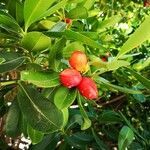A tall shrub with a spreading habit. It grows 3-8 m tall. The young plant parts are shiny. The leaves grow in rings of three around the stalk. The leaves are 8-20 cm long by 4-8 cm wide. They are dark green, shiny and leathery. The flower are short and in the angles of upper leaves. They are 0.8 cm long, have a scent and are white. The fruit are large and colourful. They are 3-6 cm long by 1-2 cm wide. They are bright red and pointed. Fruit are poisonous. Seeds are about 1 cm across, round and with a wing along them.
Trees to 6 m tall, glabrous. Petiole 1.5-2 cm; leaf blade obovate to broadly elliptic, 8-15 X 3-5 cm, apex obtuse or short acuminate. Cymes corymbose. Flowers sessile. Sepals ovate, ca. 2 mm, not ciliate, apex obtuse. Corolla white, cylindric, tube ca. 1 cm; lobes linear, ca. 6 mm. Anthers narrowly oblong. Drupes ellipsoid, 2-4 X ca. 1 cm. Seeds suborbicular, narrow margined. Fl. Jun.


